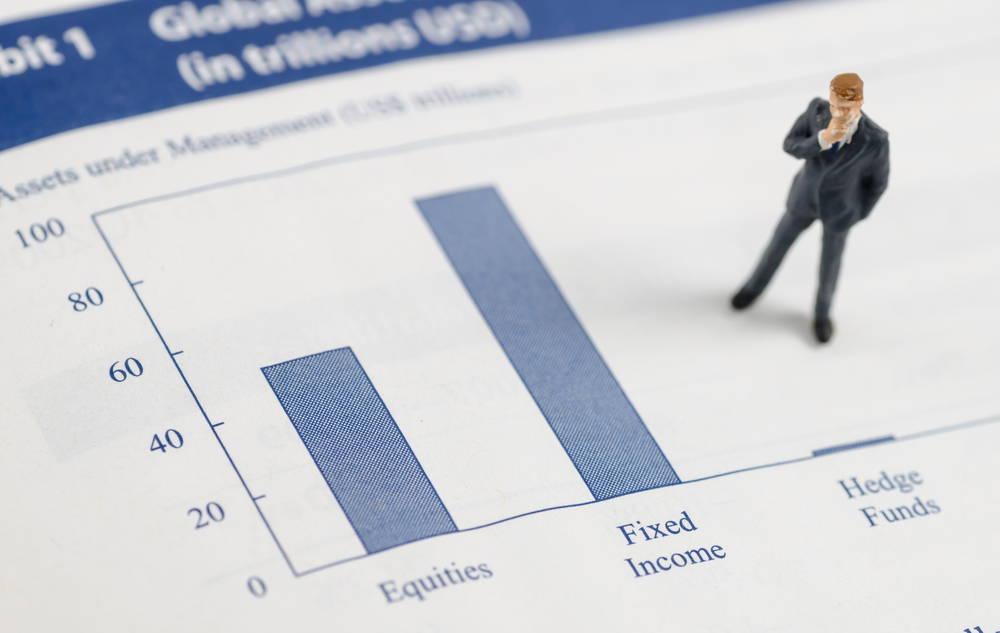For most investors, stocks and bonds go together like peanut butter and jam. They’re the two main pillars of a well-balanced portfolio; the key ingredients in your long-term wealth.
While stocks get headlines, fixed income (another name for bonds) is a more low-key source of cash flow and capital preservation. Often, when stocks are declining in value, fixed income is gaining in value, making them an important hedge.
The bond market also happens to be much larger than the stock market. But deciding on what types of fixed income you should own depends on factors like your age and risk tolerance.
What Is Fixed Income?
A city wants to build a new school; a company is looking to expand production. The government needs to support children facing poverty. A company needs to expand production.
These entities borrow money by selling bonds, which is just another word for fixed income.
Fixed income debt securities are issued with a specific maturity date and interest rate—the so-called coupon. During the life of the bond, interest payments are made on a regular basis, typically twice a year. At maturity, the issuer repays the principal, or par value, of the security.
Dependable and timely payments is why fixed income is such a desirable asset, especially for older retirees. Of course, there are trade-offs.
Inflation can eat away the value of the bond’s interest payments, while struggling companies may not make good on their debt obligations.
And if you own a basket of bonds in a mutual or exchange-traded fund, rising interest rates from the RBA could cause the value of your investment to go down.
How Fixed Income Works
To illustrate how fixed income securities work, let’s assume the fictional Acme Corporation needs to raise capital for a new production facility.
Acme has the highest possible bond rating and needs $10 million in funds. The company prepares to sell bonds with a par value of $1,000.
If an investor purchases a bond directly from Acme, they pay the face value. Bonds trade in the secondary market, and may trade above par, at a premium, or below par at a discount.
Let’s assume we buy the bonds directly from Acme and hold them to maturity. The bonds pay 4% semi-annually on the face value of $1,000 and mature in 10 years.
Under this scenario, each bond pays $40 annually in two payments of $20 each. At the end of 10 years when the bond matures, the bondholder will be repaid the $1,000 principal and will have earned $400 in interest.
Types of Fixed Income
There are many different types of fixed income securities, and each one is characterised by unique features, including tax treatment.
Government bonds are the most secure fixed income investments, but corporate bonds are a popular choice for Australian investors, too.
- Government bonds: These bonds are issued by the government, with a standard Australian government bond (AGB) guaranteeing a rate of return on the bond’s value when held to maturity. These are known as treasury bonds.
- Corporate bonds: As the name suggests, corporations sell these types of fixed income securities. The yield typically depends in part on the creditworthiness of the issuer. The higher the credit rating, the lower the coupon rate, since they’re deemed more likely to pay back the principal.
Fixed Income Advantages
Diversification
Investors never want to have their eggs in one basket. Take 2008, for instance. The ASX dropped 54.5% in that terrible year, while the bond market continued to “function well” according to the RBA.
While it is true that stocks tend to beat bonds over the long haul, you’re better off moderating your risk, especially in the near term.
Income Generation
Due to the fixed coupon payments that investors receive at specified intervals, bonds can provide a steady and predictable flow of income. Keep in mind, however, that you have to be cautious of what tax you may need to pay on this income.
Capital Preservation
Bonds make sense for money that you’ll need in five–to–10 years, an important consideration for retirees who are more sensitive to portfolio volatility as they have less time to recoup losses.
Fixed Income Risks
Interest Rate Risks
Fixed income securities are very sensitive to changes in interest rates. When rates rise, bond prices fall. Conversely, when rates fall, prices rise.
These price changes impact the value of the fixed income investment. Movements in interest rates tend to cause price volatility in the bond market, and the risk is higher for longer duration bonds.
That’s one reason why the total return on bond funds have performed so poorly during the RBA’s rate rise hike.
Inflation Risks
Bonds provide a regular income stream, but the purchasing power of this income can deteriorate when inflation rises.
Credit Risk
Credit risk is the extent to which a company might be likely to default, in which case the bondholder could lose some, or all, of their principal.
While fixed income securities are subject to credit risk, credit ratings from bond ratings agencies can offer a dependable estimation of an issuer’s risk.
Highly-rated securities are conservative investments and attractive to investors seeking capital preservation in addition to income. The lower a bond’s level of risk, the lower the payment.
Liquidity Risks
This is the risk that a bondholder may be unable to sell a fixed income security due to a lack of buyers. In an illiquid market, an investor may be forced to sell at a lower price than they paid for the investment.
How To Invest In Fixed Income
Bonds always have a place in your investment portfolio. Younger investors can take more risk and can allocate more assets to equities, but they’ll still have at least some money in bonds for diversification.
As investors age, risk tolerance declines and the allocation to fixed income rises. At retirement, many investors choose a large allocation to fixed income due to their income and capital preservation needs.
Every investor must assess their risk tolerance and stage in the investor life cycle to determine their asset allocation.
While retail investors can buy bonds directly from the issuer, this can be challenging. Purchasing bonds in the secondary market through a broker could entail high transaction costs and high investment minimums. Moreover, building a diversified bond portfolio requires significant investment.
The easiest way for the individual investor to access diversified fixed income investments is through bond mutual funds and bond exchange-traded funds (ETFs), although there are other ways, too.








